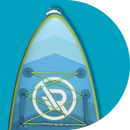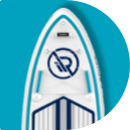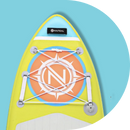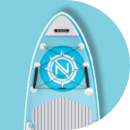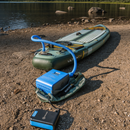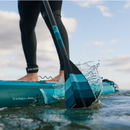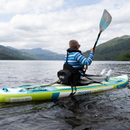Tips for SUP floating and SUP fishing in windy conditions

Here in Calgary, Canada, at the foot of the Canadian Rockies, paddle boards have risen in popularity. A great addition to an active, outdoor lifestyle, you can use your paddle board year-round to access spectacular remote locations, drift scenic glacial rivers, or fly-fish idyllic alpine lakes. Many enthusiasts relish the portability and carrying utility of these boards. Others enjoy the stunning views and the feeling of "walking on water" amongst soaring peaks and glassy mountain tarns.
It's important to note that mountain weather is incredibly varied and notoriously nasty. Temperatures plummet to well below -30F (-35C) in the winter and soar above 90F (35C) in the summer. Summer days in the alpine region can begin calm and tranquil, then quickly develop into monstrous thunderstorms, with raging winds and lightning. It's rare to have a day where conditions don't change, and therefore it's a good practice to get used to paddling in various weather, including rain, snow, and wind.
UNDERSTANDING HOW WIND AFFECTS YOUR INFLATABLE PADDLEBOARD EXPERIENCE
Something many first-time paddlers will notice is that inflatable paddle boards are very susceptible to wind. When standing, the paddler essentially becomes a sail, which can significantly affect where, how quickly, and how confidently you can travel. The effect of the wind can be diminished noticeably by shifting to a kneeling or sitting position. But like any wise sailor, it is better to go with the flow than fight against it!
1. START YOUR PADDLE BY HEADING INTO THE WIND
This is perhaps the most helpful advice for first-time paddlers who haven't yet developed the confidence to put the power down and move swiftly across the water in high-wind conditions. If you are paddling on a large body of water and intend to return to your starting location, it is best to begin your float by paddling directly into the wind.
As you tire, you will drift back towards your starting point and avoid you having to paddle aggressively against a headwind. I've battled headwinds for many miles in windy mountain passes, which can be exhausting and frustrating. Savvy paddlers take note of the winds and enjoy a leisurely drift home.
2. KNOW WHAT TO EXPECT
In the Rockies, we have a saying, "If you don't like the weather, just wait an hour." Conditions in the mountains change rapidly. I've experienced sweltering heat and snow-showers in the same afternoon and temperature swings of over 30C (90F).
A clear day in the alpine region can quickly turn to pouring rain or blanketing snow as weather systems pass through and mother nature sends humbling reminders of who's in charge! It's a good policy to research the weather in advance, and the more extended or remote the outing, the more thorough research required!
In the summer, pay particularly close attention to the chance of storms, prevailing winds, and UV indices. Typically, the hotter the day, the more convective energy to drive currents and build thunderstorms. All these factors are intensified at higher elevations, and it can make the difference between a relaxing paddle and an "old-man-versus-the-angry-seas" sort of a day.

Winter paddling can present some excellent conditions, as the colder weather typically brings stability and clear sparkling winter scenery. But due to sub-zero air and frigid water temperatures, you must take special considerations to stay warm and dry.
3. PLAN TO DRIFT FACING DOWNWIND
Inflatable paddle boards are fantastic platforms for fishing, providing better visibility into the water than kayaks or canoes. This is due to the higher angle of refraction and a comfortable standing position for casting on your SUP. However, they can be tough to manage in the wind, as your hands will likely be occupied fishing and only sporadically available to work the paddle.
In the standing position and windy conditions, the inflatable paddle board will naturally want to turn to face downwind (your back to the wind). You can use this knowledge to plan your float, starting upwind of the desired track, casting forward off the bow, and letting the wind push you precisely where you'd like to go.
4. POSITION YOUR INFLATABLE PADDLEBOARD PERPENDICULAR TO THE WAVES
High winds mean larger waves and more difficulty maintaining your balance on a SUP. If you're struggling to stay on your feet, it's usually easier to face directly into the waves and the wind. Lateral rolling and yawing motions do a far better job of throwing a paddler off-balance than pitching up and down. Also, small waves are easier to manage when they are visible directly ahead. And it helps to keep paddling. The paddle strokes stabilize and provide thrust as you top out on chop or small white caps.
5. LOOK FOR LEE, AND CRAB
If you can't resist a paddle on a windy day (I know the feeling), you can often find more manageable water on the leeward side of islands or trees, or near shore, where the currents are slower. In any case, it helps to focus on good paddling technique and consistency, and if you still can't make progress, crabbing at an angle to the wind may help. If all else fails, attempt to reduce the size of the sail (that's you) by kneeling or sitting on the stand-up paddle board and simply taking the easiest path back to shore.
EQUIPMENT THAT MIGHT BE HELPFUL:
Are you paddleboarding in windy conditions or trying to fish in a current? The iROCKER SUP Anchor will keep you pinned down and secured so that you can get the great catch without the hassle! Plus, an integrated paddle board fishing rod holder will adds convenience, letting you focus on reeling in your catch rather than juggling your gear. Now, you can truly make the most out of your aquatic adventure.
The SUP to Kayak Conversion Kit will allow you to rest comfortably and continue to paddle in rough or windy conditions from a seated position for a more stable paddle.
Don't forget to check out our range of paddle board fishing accessories, including tackle boxes and cooler mounts, to make your fishing experience even more seamless. Now, you can truly make the most out of your aquatic adventure with all the essentials at your fingertips.
These are just a few tips to help you better manage your SUP in windy conditions. If you have other suggestions, anecdotes, or helpful tips for fellow paddlers, feel free to drop a comment below!
Happy paddling!
Kayle.
IG: life.of.luft
About the Author:
Hi there! I’m Kayle Luft, a life-lovin’ Albertan with a passion for adventure and the outdoors. I’m a professional pilot, musician, business manager, photographer, writer, and a travel and fitness enthusiast. I’ve travelled around the world, run ultra-marathons, scuba-dived exotic shipwrecks, flown remote skies under the northern lights, survived avalanches and nights lost in the wilderness, and motorcycled, skated, skied, camped, climbed, paraglided, paddled and fished countless hours in the backcountry and all over the Canadian Rockies. An old friend once told me, “The more you LIVE, the more you’ll want to live forever.” He was right, and it’s become a goal of mine to share the joy abundant in life’s adventure. Here's to a wonderful journey!
If you have the one friend or family member always telling tales of their latest catch. Check out our Fishing collection and introduce them to the endless possibilities of SUP fishing and help them reel in the next big one with these essentials.
